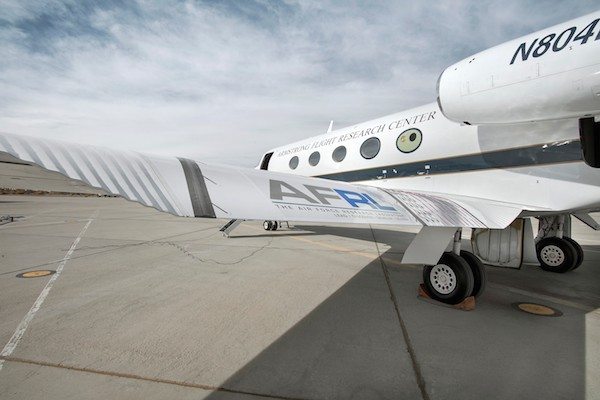A feature of aircraft design unchanged for nearly a century may have been twisted into a new shape as a result of a revolutionary new structure being tested in the Mojave Desert.
A specially modified Gulfstream III jet successfully took to the skies over NASA’s Armstrong Flight Research Center Nov. 6 using shape changing wings rather than the standard wing flaps.
The seamless, bendable and twistable surfaces promise to improve aerodynamic efficiency and reduce noise generated during takeoffs and landings.
The Adaptive Compliant Trailing Edge, or ACTE, program is an Air Force Research Laboratory project using flaps designed and built by FlexSys, Inc., of Ann Arbor, Mich. The effort is partnered with NASA’s Environmentally Responsible Aviation project for exploring the feasibility, benefits and technical risks of enabling technologies and vehicle concepts that will reduce aviation’s impact on the environment.
“We’re thrilled this first flight has been a major success and we’re hopeful that further testing will bear out our theories for the potential benefits for this technology,” said Pete Flick, AFRL program manager.
He noted that successful completion of ACTE flight research will cap nearly 20 years of collaboration between AFRL and FlexSys.
With AFRL funding through the Air Force’s Small Business Innovative Research program, FlexSys developed a variable geometry airfoil system called FlexFoil™ that can be retrofitted to existing airplane wings or integrated into brand new airframes. FlexFoil’s inventor, FlexSys founder and CEO Sridhar Kota hopes testing with the modified G-III will confirm the design’s flight-worthiness and open doors to future applications and commercialization.
“Twenty years ago when I approached AFRL with this method, they had the vision to recognize the merit of our design and they have funded us through SBIR Phase 2 and 3 all the way to this flight test. FlexSys replaced the primary trailing edge wing flaps on a Gulfstream III business jet with 18-foot span-wise FlexFoil™ aircraft control surfaces on each wing, including 2-foot wide compliant fairings at each end to eliminate noise-generating gaps in the airframe. With these, it is intended that they’ll be able to alter the wing’s camber, or cross-section, seamlessly on demand to maximize performance throughout the whole flight. The aeronautics community has been trying to accomplish this for almost 40 years,” Kota said.
“This technology can be applied to all kinds of surfaces moving through a fluid medium such as airplane wings, engine inlets, helicopter rotors, and wind turbines, as well as specialized components for automobiles, boats, and submarines,” said Kota, who is also a professor of mechanical engineering at the University of Michigan.
The technology looks to solve a problem that has long faced aircraft designers. Wing flaps that tilt and separate from the wing introduce gaps that produce unwanted drag and a lot of aerodynamic noise, according to Kota. Conventional flaps are also unable to make the fine adjustments necessary at certain phases of flight or when flight conditions are less than optimal.
The FlexFoil structure eliminates these gaps offering potential noise reduction and fuel savings as well as enhanced stability in flight.
“We have progressed from an innovative idea, and matured the concept through multiple designs and wind tunnel tests, to a final demonstration that should prove to the aerospace industry that this technology is ready to dramatically improve aircraft efficiency,” Flick said. “This is a very exciting time for this program.”










